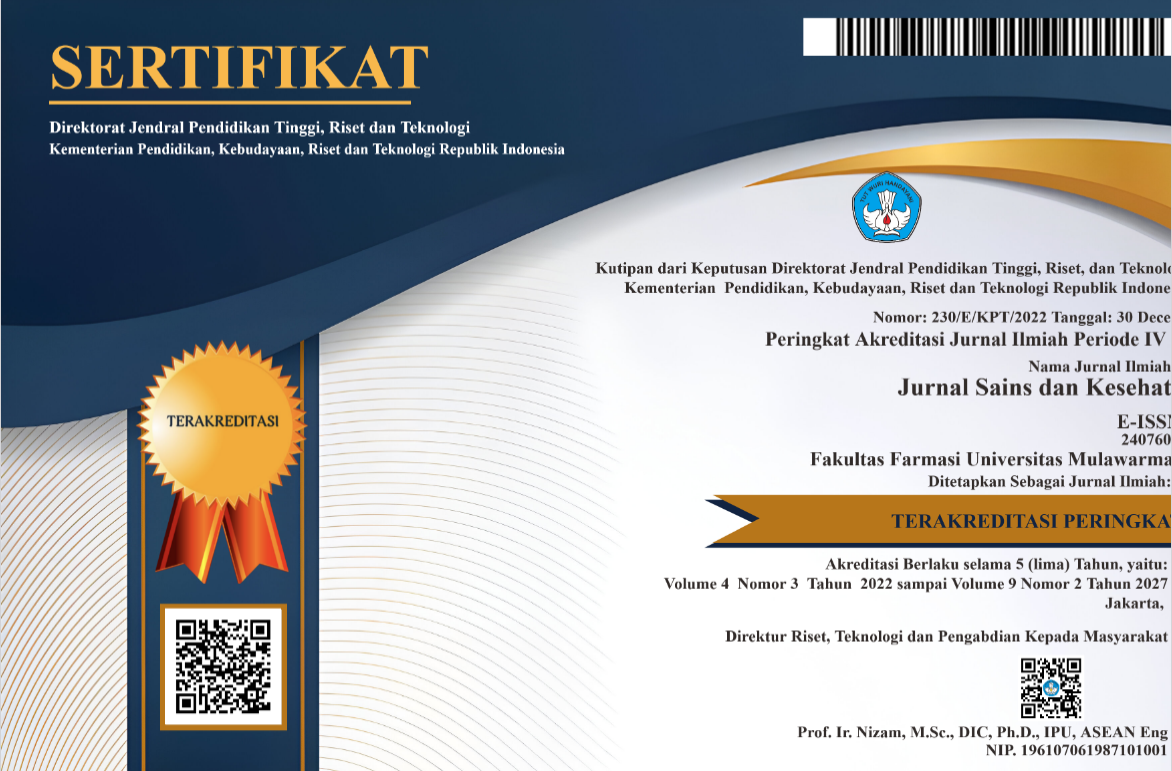Aktivitas Antiinflamasi In Vitro dan In Vivo Ekstrak Etanol Daun Mangga Arumanis (Mangifera indica L.)
In Vitro and In Vivo Anti-Inflamatory Activities of Ethanol Extract Mangifera indica L. Leaves
Keywords:
Mangifera Indica L., antiinflamation, in vitro, in vivo, leaves extractAbstract
References
D. E. Becker, “Basic and clinical pharmacology of Glucocorticosteroids,” Anesth. Prog., vol. 60, no. 1, pp. 25–32, 2013, doi: 10.2344/0003-3006-60.1.25.
D. Furman et al., “Chronic inflammation in the etiology of disease across the life span,” Nat. Med., vol. 25, no. 12, pp. 1822–1832, 2019, doi: 10.1038/s41591-019-0675-0.
S. V. Stankov, “Definition of Inflammation, Causes of Inflammation and Possible Anti-inflammatory Strategies,” Open Inflamm. J., vol. 5, no. 1, pp. 1–9, 2012, doi: 10.2174/1875041901205010001.
L. A. Abdulkhaleq, M. A. Assi, R. Abdullah, M. Zamri-Saad, Y. H. Taufiq-Yap, and M. N. M. Hezmee, “The crucial roles of inflammatory mediators in inflammation: A review,” Vet. World, vol. 11, no. 5, pp. 627–635, 2018, doi: 10.14202/vetworld.2018.627-635.
O. O. Oguntibeju, “Medicinal plants with anti-inflammatory activities from selected countries and regions of africa,” J. Inflamm. Res., vol. 11, pp. 307–317, 2018, doi: 10.2147/JIR.S167789.
Y. Umi, H. Siti, O. Winda, and C. Ratu, “Aktivitas Antiinflamasi Ekstrak Etanol Buah dan Asam Jawa (Tamarindus indica) Serta Kombinasinya pada Tikus Jantan Galur Wistar,” pp. 83–88, 2015.
K. A. Shah, M. B. Patel, R. J. Patel, and P. K. Parmar, “Mangifera indica (mango),” Pharmacogn. Rev., vol. 4, no. 7, p. 42, 2010.
S. Hidayati, S. Shinta Mayasari, L. Setyaningrum, A. D. Wardani, and Q. Aini, “In vitro antidiabetic activity of Peperomia pellucida extract and fraction by alpha-amylase inhibition pathway,” Pharmaciana, vol. 12, no. 2, p. 156, 2022, doi: 10.12928/pharmaciana.v12i2.21874.
K. Kosala, M. A. Widodo, S. Santoso, and S. Karyono, “In vitro and in vivo anti-inflammatory activities of Coptosapelta flavescens Korth Root’s methanol extract,” J. Appl. Pharm. Sci., vol. 8, no. 9, pp. 42–48, 2018, doi: 10.7324/JAPS.2018.8907.
T. W. Senduk, L. A. D. Y. Montolalu, and V. Dotulong, “The rendement of boiled water extract of mature leaves of mangrove Sonneratia alba,” J. Perikan. DAN Kelaut. Trop., vol. 11, no. 1, pp. 9–15, 2020.
E. Ukieyanna, “Aktivitas antioksidan, kadar fenolik, dan flavonoid total tumbuhan suruhan (Peperomia pellucida L. Kunth),” Skripsi. Fak. Mat. dan Ilmu Pengetah. Alam. Inst. Pertan. Bogor, 2012.
A. V. A. David, R. Arulmoli, and S. Parasuraman, “Overviews of biological importance of quercetin: A bioactive flavonoid,” Pharmacogn. Rev., vol. 10, no. 20, p. 84, 2016.
A. Vafadar et al., “Quercetin and cancer: New insights into its therapeutic effects on ovarian cancer cells,” Cell Biosci., vol. 10, no. 1, pp. 1–17, 2020, doi: 10.1186/s13578-020-00397-0.
T. yang Wang, Q. Li, and K. shun Bi, “Bioactive flavonoids in medicinal plants: Structure, activity and biological fate,” Asian Journal of Pharmaceutical Sciences, vol. 13, no. 1. Shenyang Pharmaceutical University, pp. 12–23, Jan. 01, 2017, doi: 10.1016/j.ajps.2017.08.004.
E. Umapathy et al., “An experimental evaluation of Albuca setosa aqueous extract on membrane stabilization, protein denaturation and white blood cell migration during acute inflammation,” J. Med. Plants Res., vol. 4, no. 9, pp. 789–795, 2010, doi: 10.5897/JMPR10.056.
R. Ginwala, R. Bhavsar, D. G. I. Chigbu, P. Jain, and Z. K. Khan, “Potential role of flavonoids in treating chronic inflammatory diseases with a special focus on the anti-inflammatory activity of apigenin,” Antioxidants, vol. 8, no. 2, pp. 1–28, 2019, doi: 10.3390/antiox8020035.
M. Audina and K. Khaerati, “Efektivitas Antiinflamasi Ekstrak Etanol Daun Sumambu (Hyptis capitata Jacq.) Pada Tikus Jantan (Rattus norvegicus L.),” Bocelebes, vol. 12, no. 2, pp. 17–23, 2018.
Downloads
Published
Issue
Section
Deprecated: json_decode(): Passing null to parameter #1 ($json) of type string is deprecated in /home/jskff/public_html/plugins/generic/citations/CitationsPlugin.php on line 68
How to Cite
Similar Articles
- Chyntia Tresna Nastiti, Noer Halimatus Syakdiyah, Mutiara Imansari, Exploring Antifungal Potential of Qusthul Hindi (Saussurea lappa) Root against Candida albicans: A Systematic Review , Jurnal Sains dan Kesehatan: Vol. 5 No. 3 (2023): J. Sains Kes.
- Chairul Saleh, Marem Sestiani, Erwin Erwin, Aktivitas Ekstrak Metanol Daun Alang-Alang (Imperata cylindrica (L.) P. Beauv) sebagai Antinflamasi , Jurnal Sains dan Kesehatan: Vol. 5 No. 3 (2023): J. Sains Kes.
- Claudius Hendraman B. Tobi, Mustika Endah Pratiwi, Identifikasi Senyawa Flavonoid dan Uji Aktivitas Antibakteri Ekstrak Terpurifikasi Daun Beluntas (Pluchea Indica L.) terhadap Staphylococcus aureus , Jurnal Sains dan Kesehatan: Vol. 5 No. 5 (2023): J. Sains Kes.
- Yonathan Tri Atmodjo Reubun, Shirly Kumala, Siswa Setyahadi, Partomuan Simanjuntak, Freezed Drying of Kelor Leaves Extract (Moringa oleifera Lam.) , Jurnal Sains dan Kesehatan: Vol. 3 No. 4 (2021): J. Sains Kes.
- Usman Usman, Pintaka Kusumaningtyas, Sukemi Sukemi, Erwin Erwin, An Evaluation of the Antidiabetic and Antimicrobial Activity of an Ethanolic Extract from Rhizophora mucronata Leaf , Jurnal Sains dan Kesehatan: Vol. 5 No. 4 (2023): J. Sains Kes.
- Nisa Najwa Rokhmah, Moerfiah Moerfiah, Hijib Sihabullah, Analgesic Activity of Bitter Melon Leaves Ethanol Extract in Mice (Mus musculus) , Jurnal Sains dan Kesehatan: Vol. 3 No. 4 (2021): J. Sains Kes.
- Andre Kusuma Ruslim, Silvia Anitasari, Sjarif Ismail, Eka Marwansyah Oli'I, Sinar Yani, Effect of African Leaves Extract (Vernonia amygdalina DEL.) on Wound Healing Velocity after Tooth Extraction in Rattus norvegicus , Jurnal Sains dan Kesehatan: Vol. 1 No. 8 (2017): J. Sains Kes.
- Jhon Patar Sinurat, Reh Malem Br Karo, Rinaldo Berutu, Determination of Total Flavonoid Content of Saputangan Leaves (Maniltoa grandiflora (A. Gray) Scheff) and Its Ability as Antioxidant , Jurnal Sains dan Kesehatan: Vol. 4 No. 3 (2022): J. Sains Kes.
- Joni Tandi, Yustin Yustin, Rezky Yanuarty, Tien Wahyu Handayani, Test the Effect of Miana Leaf Ethanol Extract on Ureum and Creatinine Levels in Male White Rats , Jurnal Sains dan Kesehatan: Vol. 4 No. SE-1 (2022): Spesial Edition J. Sains Kes.
- Astuti Amin, Nur Khairi, Wahyu Hendrarti, Aktivitas Antioksidan Ekstrak Etanol Batang, Daun, dan Akar Kopasanda (Chromolaena odorata L.) dengan Metode FRAP (Ferric Reducing Antioxidant Power) , Jurnal Sains dan Kesehatan: Vol. 4 No. 5 (2022): J. Sains Kes.
You may also start an advanced similarity search for this article.




